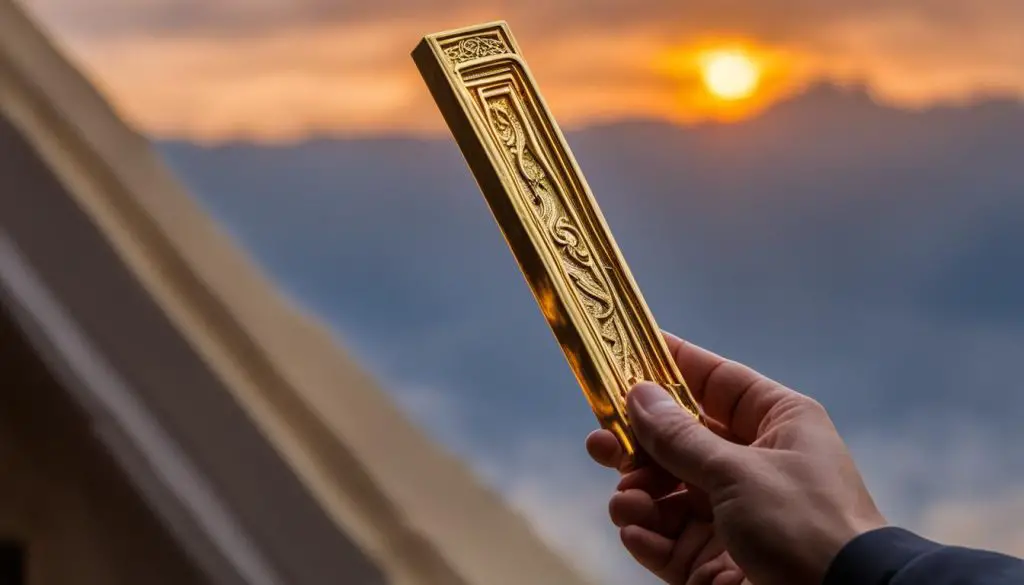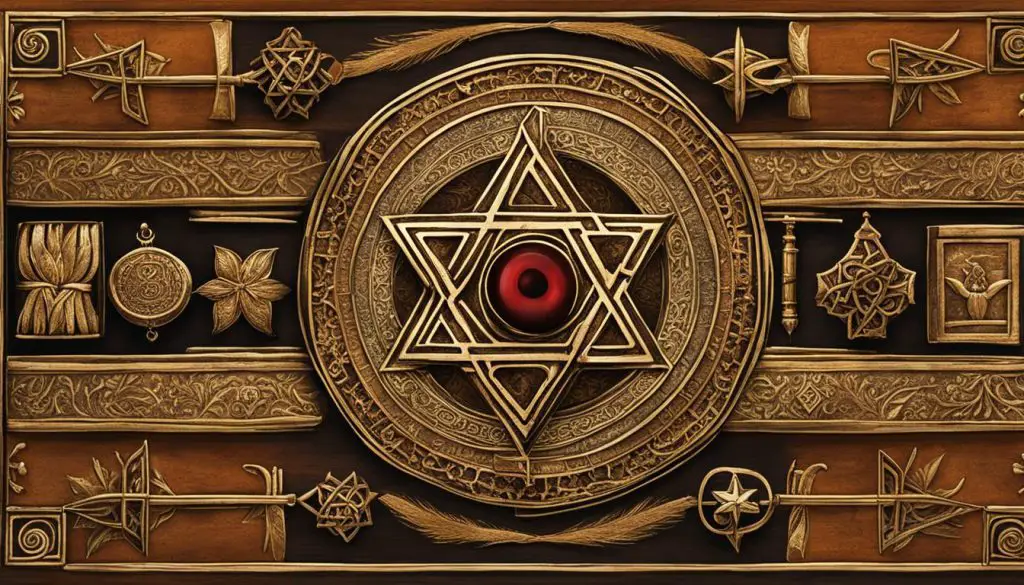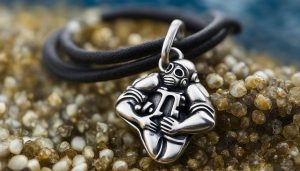Welcome to our article on the fascinating world of Jewish home decor! In this section, we will be diving deep into the symbolism and meaning behind the Jewish good luck thing that you often see by the front door. Have you ever wondered what it is and why it holds such importance in Jewish culture? Let’s explore together!
But before we begin, let’s familiarize ourselves with some key terms: Jewish home decor, Jewish symbols, front door amulets, and Jewish culture. These concepts will guide us through this enriching journey as we uncover the significance of the Jewish good luck thing by the front door.
Contents
- 1 The Meaning and Significance of the Mezuzah
- 2 Rituals and Customs Associated with the Mezuzah
- 3 Choosing a Kosher Mezuzah
- 4 Other Jewish Good Luck Charms
- 5 Conclusion
- 6 FAQ
- 6.1 What is a mezuzah?
- 6.2 Is the mezuzah a good luck charm?
- 6.3 What does the mezuzah scroll contain?
- 6.4 How should a mezuzah be affixed to the doorpost?
- 6.5 How often should a mezuzah be checked?
- 6.6 Where can I purchase a kosher mezuzah?
- 6.7 Are there any other Jewish good luck charms?
- 6.8 What do these charms symbolize?
- 7 Source Links
Key Takeaways:
- The Jewish good luck thing by the front door is called a mezuzah.
- It is a small casing containing a handwritten scroll of parchment with verses from the Torah.
- The mezuzah is a reminder of God’s presence and his commandments.
- It symbolizes Jewish identity and faith when placed on the doorposts of Jewish homes.
- The mezuzah is not just a good-luck charm but a source of blessings, protection, and luck.
The Meaning and Significance of the Mezuzah
The mezuzah holds great meaning and significance in Jewish beliefs and traditions. Derived from the commandment in the Book of Deuteronomy, the mezuzah serves as a constant reminder of God’s presence and his commandments. It is believed to bring blessings, protection, and luck to the home.
The mezuzah scroll contains the first two paragraphs of the Shema, which affirm the oneness of God and the importance of fulfilling his will. By affixing the mezuzah to the doorpost, Jews express their commitment to honoring and obeying God’s commandments.
The mezuzah not only serves as a spiritual symbol but also as a physical representation of Jewish identity and faith. By displaying the mezuzah on the doorposts of their homes, Jews proclaim their connection to Jewish culture and traditions.
The Significance of the Mezuzah
“The mezuzah is a powerful reminder of our relationship with God and our commitment to living a faithful life. It is a symbol of protection and a source of blessings for our home and family.” – Rabbi David Cohen
Each time a person passes through a door with a mezuzah, it is customary to kiss their fingers and touch them to the mezuzah. This act of love and respect for God and his commandments is a way to acknowledge his presence and seek his blessings.
It is important to note that the mezuzah is not a good-luck charm but a spiritual reminder. Its significance lies in its connection to Jewish beliefs, traditions, and the commitment to following God’s commandments.
| Symbol | Meaning |
|---|---|
| Hamsa | A hand-shaped amulet associated with divine protection. |
| Ana Bekoach Prayer | A powerful prayer believed to bring luck and guidance. |
| Red String Bracelets | Worn to ward off negativity and bring luck. |
| Evil Eye Jewelry | Believed to protect against the evil eye and bring good luck. |
These other Jewish good luck charms, including the Hamsa, Ana Bekoach prayer, red string bracelets, and Evil Eye jewelry, are also widely embraced in Jewish culture. Each symbol carries its own unique significance and is believed to offer protection and luck to those who wear or display them.
By incorporating these charms into their lives, individuals can embrace and showcase their Jewish pride while carrying a piece of tradition and symbolism with them.
Rituals and Customs Associated with the Mezuzah
Channukat Ha-Bayit, also known as the dedication of the home, is an important ritual associated with affixing a mezuzah to the doorpost. This ceremony involves reciting a blessing to sanctify the space and welcome God’s presence into the home. It is customary for family and friends to gather for this special occasion, creating a sense of community and celebration.
When attaching the mezuzah to the doorpost, it is common to affix it at a slight angle. This particular angle is believed to be reminiscent of the Hebrew letter “shin,” which stands for one of the names of God. The practice of affixing the mezuzah at an angle also serves as a visual reminder of the importance of being mindful of God’s commandments in everyday life.
“Kiss the mezuzah.” This phrase is often heard in Jewish households as a reminder to touch the mezuzah with their fingers and then kiss them. This act of reverence allows individuals to express their love and respect for God and his commandments, acknowledging their presence in their lives. It is a simple yet powerful gesture that serves as a daily reminder of one’s faith and devotion.
| Ritual | Description |
|---|---|
| Channukat Ha-Bayit | Reciting a blessing to sanctify the home and welcome God’s presence. |
| Angled Affixing | Attaching the mezuzah at a slight angle as a symbol of God’s commandments. |
| Kissing the Mezuzah | Touching and kissing the mezuzah to express love and respect for God and his commandments. |
It is worth noting that when moving to a new home, it is recommended to remove the mezuzah and replace it in the new space. This is done to prevent the mezuzah from being treated with disrespect or accidentally damaged during the moving process. By upholding this custom, individuals ensure the continued sanctity and significance of their mezuzah.

“The mezuzah is a constant reminder of our connection to God and the importance of living a life in accordance with his commandments.” – Rabbi David Cohen
Choosing a Kosher Mezuzah
When selecting a mezuzah for your home, it is important to choose one that is kosher, ensuring it fulfills the requirements of Jewish law. A kosher mezuzah must be hand-written on genuine parchment by a specially trained scribe. Mechanically printed scrolls do not fulfill the mitzvah of the mezuzah. Therefore, it is crucial to purchase a mezuzah from trusted sources that provide certification from the Vaad Mishmeret Stam, guaranteeing the authenticity and adherence to kosher standards.
The kosher mezuzah is typically sold as a separate case and scroll. While the case can be made from a variety of materials and designs, the scroll itself is the essential component. It contains the handwritten verses from the Torah, specifically the first two paragraphs of the Shema. The parchment and ink used in creating the scroll must also meet strict requirements to ensure its kosher status.
It is recommended to have your mezuzah checked every seven years for any damage or fading of the letters. This inspection ensures that the mezuzah remains valid and effective in fulfilling its purpose. To maintain the mezuzah’s integrity, it is advised to avoid touching the actual parchment when handling or affixing it to the doorpost. Instead, hold the mezuzah by its case to prevent any accidental damage.
| Kosher Mezuzah Checklist | |
|---|---|
| 1. Handwritten on genuine parchment |
|
| 2. Specially trained scribe |
|
| 3. Certification from Vaad Mishmeret Stam |
|
| 4. Properly inspected every seven years |
|
By choosing a kosher mezuzah, you can be confident that you are upholding Jewish traditions and fulfilling the mitzvah associated with this sacred object. Not only does it serve as a symbol of faith and identity, but it also brings blessings and protection to your home. Incorporating a kosher mezuzah into your Jewish home decor is a meaningful way to connect with your heritage and strengthen your spiritual connection.
Other Jewish Good Luck Charms
In addition to the mezuzah, there are other Jewish symbols and amulets believed to bring good luck and protection. These talismans are deeply rooted in Jewish culture and tradition, serving as powerful reminders of faith and spirituality. Let’s explore some of the most popular Jewish amulets and the symbolism behind them.
Hamsa

The Hamsa, also known as the Hand of God, is an open hand-shaped amulet that is widely used in Jewish culture. It is believed to offer divine protection and bring luck to its wearer. The five fingers of the Hamsa represent the five books of the Torah, symbolizing God’s protection and guidance. The Hamsa is often worn as a pendant or displayed as a decorative item in homes to ward off evil spirits and bring good fortune.
Ana Bekoach Prayer
The Ana Bekoach prayer is a powerful Hebrew prayer that is often written on jewelry and amulets. This prayer is believed to have mystical properties and is associated with luck, guidance, and spiritual elevation. It consists of seven verses, each with its own spiritual significance. Wearing jewelry with the Ana Bekoach prayer is a way to stay connected to Jewish spirituality and find strength in its teachings.
Red String Bracelets and Evil Eye Jewelry
Red string bracelets and Evil Eye jewelry are also commonly worn as protective amulets in Jewish culture. The red string bracelet is believed to ward off negative energies and bring good luck, while Evil Eye jewelry is thought to protect against the evil eye, a malevolent gaze believed to cause harm. These symbols are rooted in Kabbalah teachings and are popular among people seeking spiritual protection and positivity.
These Jewish talismans carry deep symbolism and meaning, reflecting the rich cultural heritage of the Jewish people. Incorporating these charms into your life can serve as a constant reminder of faith and spirituality, bringing luck, protection, and positive energy.
| Amulet | Symbolism |
|---|---|
| Hamsa | Divine protection, guidance, and good fortune |
| Ana Bekoach Prayer | Luck, guidance, and spiritual elevation |
| Red String Bracelets | Warding off negative energies and attracting good luck |
| Evil Eye Jewelry | Protection against the evil eye and negativity |
Conclusion
Jewish good luck charms, such as the mezuzah and other symbols, hold deep meaning and significance in Jewish culture and traditions. They serve as reminders of God’s presence and his commandments, bringing blessings, protection, and luck to your home and life.
These charms are not just decorative items, but symbols of Jewish identity and faith. By incorporating these charms into your home and personal accessories, you can showcase your Jewish pride and carry a piece of tradition with you wherever you go.
Embracing Jewish good luck charms allows you to connect with Jewish culture and traditions, fostering a sense of belonging and heritage. Whether it’s a mezuzah on your doorpost, a Hamsa pendant, or an Ana Bekoach bracelet, these symbols provide a sense of comfort and connection to your roots.
So, explore the world of Jewish good luck charms and find the ones that resonate with you. Embrace the rich traditions of Jewish culture and let these symbols bring luck and blessings into your life.
FAQ
What is a mezuzah?
A mezuzah is a small casing containing a handwritten scroll of parchment with verses from the Torah. It is placed on the doorposts of Jewish homes as a symbol of Jewish identity and faith.
Is the mezuzah a good luck charm?
No, the mezuzah is not a good luck charm. It is a reminder of God’s presence and his commandments.
What does the mezuzah scroll contain?
The mezuzah scroll contains the first two paragraphs of the Shema, affirming the oneness of God and the importance of fulfilling his will.
How should a mezuzah be affixed to the doorpost?
The mezuzah is usually affixed at an angle, but some Jewish communities affix it straight up and down.
How often should a mezuzah be checked?
Mezuzahs should be checked every seven years for any damage or fading of the letters.
Where can I purchase a kosher mezuzah?
Kosher mezuzahs can be purchased from trusted sources with certification from the Vaad Mishmeret Stam.
Are there any other Jewish good luck charms?
Yes, there are other symbols and amulets in Jewish culture, such as the Hamsa, Ana Bekoach prayer, red string bracelets, and Evil Eye jewelry.
What do these charms symbolize?
These charms symbolize Divine protection, luck, and warding off negativity.





